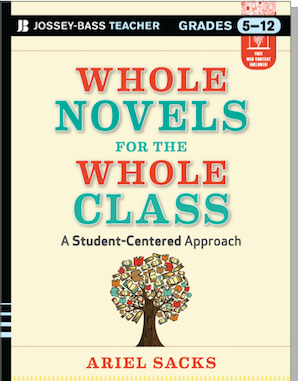Teaching Whole Novels for Love and Standards
Whole Novels for the Whole Class: A Student-Centered Approach
by Ariel Sacks
(Jossey-Bass Teacher, 2013 – Learn more)

Some books give you ideas to mull over and think about for Someday. Others give you ideas and resources to use Monday. Whole Novels for the Whole Class gives you both.
In this book Ariel Sacks shares her passion and expertise in how to best guide secondary students towards the love of reading. From page one, it becomes clear that in her daily journey to help transform reluctant readers into willing ones, she actually transforms reluctant readers into eager ones. Thankfully, Sacks allows us a glimpse into her classroom to observe the metamorphosis.

Reading for the love of it
The book is peppered with resources that teachers can use immediately, highlighted by short videos where you get to see not only the resource in action, but Sacks herself. In these clips, you can really appreciate the calm control she has with students as she releases her own authority to them. She creates an environment that supports students’ ownership of their reading and their learning.
As a middle school Language Arts teacher myself, I am constantly looking for ways to excite my vastly diverse clientele in regards to reading. It’s hard, as we all know, to lure in students who read at so many different levels and who possess so many different interests. Whole Novels for the Whole Class not only gave me ways to rethink how I teach books, it also sparked a renewed enthusiasm for teaching the love of reading that had somehow become dormant with the recent trend towards a more narrative-sparse classroom.
When a master teacher like Sacks opens up her classroom, we eagerly walk in to learn. So now we have this book that shares her experiences, her research, and her brain, and for that we are all the richer. With every teacher who picks up this book, classrooms full of students will gain the potential to become lifetime lovers of narrative fiction.
Sacks approaches literature as a means to teach critical thinking by acknowledging that deep thinking doesn’t happen until passion does. She gives advice on how to cultivate that enthusiasm for reading first and foremost before launching into ways to leverage that newfound passion into assessable knowledge.
What’s in the book
Whole Novels for the Whole Class is well organized, divided into sections that each serve a different purpose. I don’t know about you, dear reader, but when I read a book through the lens of my own learning, I first read it straight through and then want to be able to go back and dissect different sections as needed. (Funny, that’s just what Ariel Sacks recommends in her book.) The organization of Whole Novels for the Whole Class makes this very easy to do as the book is clearly segregated into Big Ideas/Essential Practices, How to make whole novels apply to real-world contexts, and Resources (including videos, links, and scaffolded materials). Very helpful.
Using both anecdotal and research-based evidence, Whole Novels for the Whole Class stresses that one can still weave in informational reading while teaching novels, but that novels are the way into deeper reading. Sacks goes into details about the following:
- How to select books,
- How to create an environment that encourages discussions, and
- How to differentiate while still giving students a common experience to draw from together.
Creating common experiences is vital, as any middle school teacher knows. Our diverse student body longs for community even while testing the waters of individuality. Sacks acknowledges both needs, and adds the pixie dust of her own voice to the mix. You’ll walk away wishing she were the master teacher assigned to you.
Everything you need is here

Ariel Sacks (l.) & co-teacher Marcia Stiman-Lavian
The message in this book – encouraging passion so that learning can happen more deeply – may be one we have heard before, but Whole Novels clearly moves beyond the rationale and theory. It brings to the table what classroom teachers are always on the lookout for: the lessons and units that help teach towards college and career readiness in a way that is definitely 21st century.
Sacks has done the work for you, unveiling the legitimate connections among love of reading, sustained narratives, common experiences, deep discussions, and student-centered activities, and a whole-novel approach can help address both the Common Core standards and the necessity to prepare our students for their futures.
Among my own ELA department colleagues, I could go on and on about this resource. But I think I’ll go a different route. I’m planning to recommend Whole Novels for the Whole Class as one of our book club selections. Perhaps we’ll even experience some of the activities from a student’s perspective, participating as we would as learners. We’ll find the balance between whole class discoveries as a department and individual ones discovered through our own independent reading. After all, as Sacks states, there must be a balance between the two. It is this balance that Whole Novels insists is a vital component in any reading program, at any level.
In case you couldn’t tell, I would highly recommend Whole Novels for the Whole Class. As a tween teacher herself, Sacks generally speaks to this dedicated group of teachers about how to tap into the brain of our challenging age group. But by tackling literacy in such a universal way, she moves beyond simply giving advice for a particular age group. Her strategies go beyond the tween years. This book could have easily been called Whole Novels for the Whole School System. The strategies within are universal and appropriate for all students ready to read whole books.
Heather Wolpert-Gawron (@TweenTeacher) is an award-winning middle school teacher and passionate ed tech advocate. She is the author of ‘Tween Crayons and Curfews: Tips for Middle School Teachers and the upcoming Writing Behind Every Door: Strategies to Teach Common Core Writing Across the Curriculum (Routledge) as well as several workbooks on teaching internet literacy, project based writing and the upcoming Nonfiction Reading Strategies for the Common Core, grades 1-7. Heather blogs at Edutopia (The George Lucas Educational Foundation) and at TweenTeacher.






























